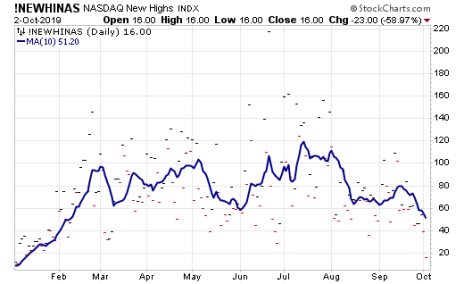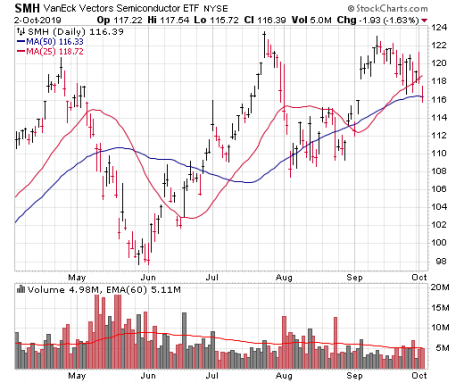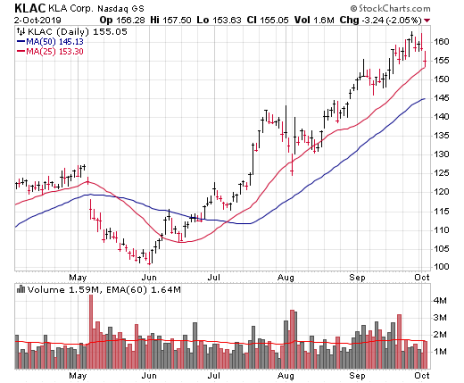Plus, One Stock Poised to Lead the Next Market Rally
I’ve frequently said that one of the toughest things about investing isn’t mastering charts or knowing how to read an income statement, but instead dealing with its contrary nature—for whatever reason, many life lessons that prove useful actually work against you when dealing with stocks, particularly winning stocks.
Take the “try, try again” attitude that many successful people possess. If you’re a good salesperson, you don’t give up because a few people say no; you continue to hit the phones and offices until you make the sale. If you’re a project manager or engineer, you’re rewarded for working late and figuring out how to fit a square peg in a round hole.
In other words, persistence and never giving up are good traits in the real world.
[text_ad use_post='129627']
In the market, though, too much persistence can do serious damage to your account. Don’t get me wrong—you don’t want to throw your hands up and quit at the first sign of adversity. But the never-say-die attitude usually leads people to (a) take huge losses and/or (b) churn their account.
The current market environment is a perfect example. It’s not so much that the market is extraordinarily weak—most major indexes are just a few percent off their highs—but it’s very choppy and rotational, with no sustained buying pressures and few stocks in clear uptrends. Indeed, take a look at the chart below, which shows the number of stocks on the Nasdaq that are hitting new 52-week highs every day. Using a 10-day moving average to smooth out the daily fluctuations, the number of new highs are at their lowest level since February.
Unless you’re a nimble day or swing trader, doing a ton of trading in this environment is akin to picking up nickels in front of a bulldozer. Can you make a few bucks? Maybe. But is it worth the risk? Probably not.
Thus, at least in terms of a position growth stock investors (intermediate- to longer-term) should take, less is more until the buyers can show up for more than a few hours.
How to Sell Winning Stocks Before They Become Losers
As stocks have come under pressure, I’ve gotten a couple of emails asking how to decide what stocks in their portfolio to sell. Obviously, when something completely implodes, the decision is easy (even if the action is painful). But what about the frequent situations when something is falling, but you still have a profit or a modest loss?
There is no perfect answer, but I like to stick with some simple, straightforward guidelines for selling winning stocks.
First, take a look at your overall position of your portfolio, preferably when the market is NOT open. What I mean is that, if you’re already 50% in cash and the stuff you’re invested in is larger-cap, more stodgy stuff, you should approach things differently than if you’re fully invested in a bunch of highfliers—in the first case, you can be more lenient with what you still own, while you might prune a few things right quick in the latter case.
In Cabot Growth Investor’s Model Portfolio, we’re a bit over half in cash at this point. That’s not a magic number—everyone runs their ship differently, and my portfolio is usually full of fast-moving names—but if we were only 15% in cash, I might throw a couple of names overboard simply to boost the cash position. But at this point, while I’m still vigilant on my remaining holdings, I’m also OK giving them a bit more room to wiggle around.
Second, when it comes to paring back, you should prioritize your biggest losers and your biggest positions. Your biggest losers are (more likely than not) your worst positions. And your largest positions are where your most risk is found.
Third, set some reasonable stops for these positions and stick to them—try to base it on a combination of the chart (below recent support) and your own risk tolerance. If you still haven’t built up any cash, it’s fine to throw your worst couple of positions overboard right away.
Obviously, you can hike those stops (or make outright sells) as the evidence changes, but from there, it’s usually best to let the market make some decisions for you—the names that trip your stops are usually ones that won’t lead the next advance, while those that resist have a better shot at tacking on big gains down the road.
Like I said above, there’s no perfect way to do it, but sticking to some basic guidelines like these will allow you to make rational decisions based on the evidence, instead of emotional decisions when the market and your stocks are getting smacked around.
Semiconductor Stocks on Fire
Back to the market, another benefit of mostly laying low besides saving money from the meat grinder environment is that it gives you a clearer head to step back and take an unemotional look at what’s going on.
One thing I find very interesting (and encouraging) right now is that a group that usually leads growth stocks to the downside is actually one of the more resilient in the market today.
I’m talking about semiconductor stocks, which, as you can see in the chart below, have actually tried to get going a couple of times this year after a very long consolidation, only to have a general market retreat (and trade war fears) yank them back in. That happened again over the past three weeks.
But while growth stocks come unglued and even the major indexes have nosedived decisively below their 50-day lines, the VanEck Vectors Semiconductor ETF (SMH) is still hanging around its own 50-day line. Could it implode from here? It’s possible, but the longer it can resist, the better the odds the sellers have moved on from the group.
One name to keep an eye on is KLA Corp. (KLAC), which is one of the strongest chip equipment names out there, and it recently had some positive words on business, too. KLA hosted its Investor Day last week and the news was all good—the firm reiterated its sales and earnings guidance, boosted its current buyback program by $1 billion (that’s in addition to the $850 million that was remaining at the end of June) and boosted its dividend, too (new yield is around 2.2%). Moreover, one analyst believes KLA’s longer-term target of $15 in earnings per share in 2023 is achievable! I won’t look out that far, but right here, the company is in great shape.
“But Mike,” you might say, “looking at this chart, KLAC has gone from 100 to 160 (round numbers) just since the start of June! Why should I look at this?” And I would simply say that’s the point—with the weak environment, KLAC has had every chance to give up the ghost, but the fact that it hasn’t is a good sign that buyers are supporting the stock on dips.
I wouldn’t say it’s a buy right here, but the longer KLAC holds up, the better the chance it can help lead the sector’s next sustained upmove.
[author_ad]




